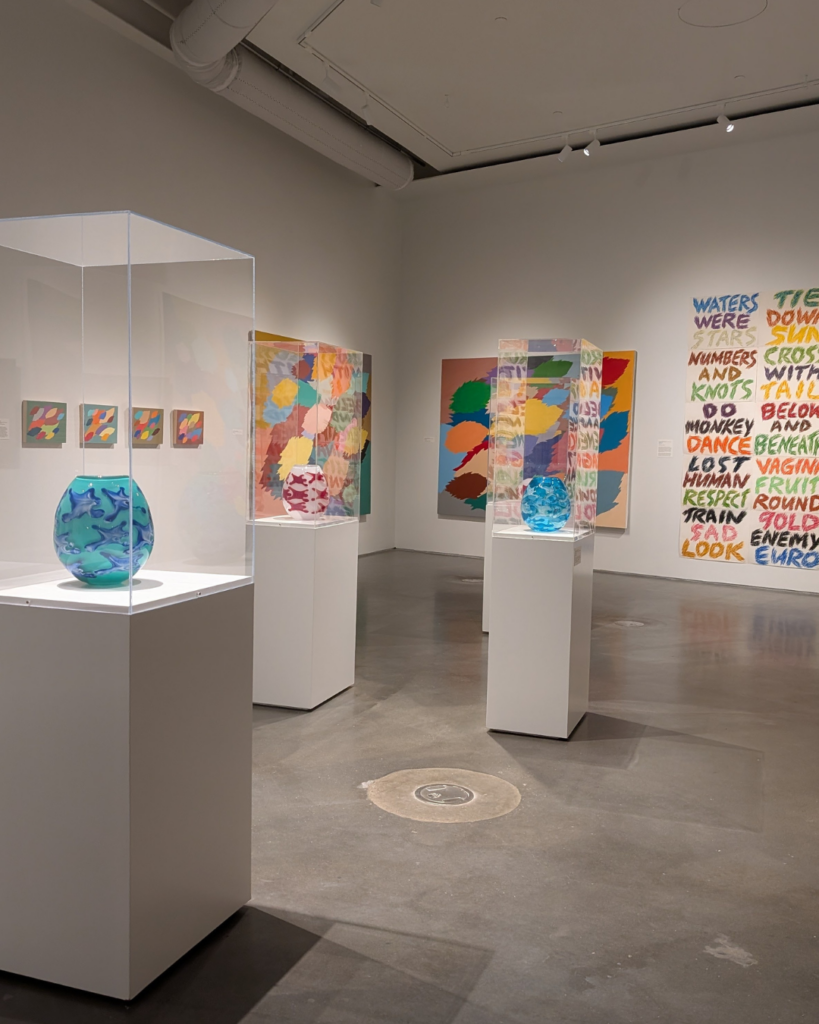
Display of HONOR SONG at OKCMOA. (Photo/Nadia Tallroth)
The First American artist, Hock E Aye Vi Edgar Heap of Birds created HONOR SONG, a striking exhibit showcased throughout the Oklahoma City Contemporary Museum of Art.
Running from February 20, 2025, to August 4, 2025, his work is open to the public free of charge, offering visitors an exploration of First American history and culture.
To understand the impact of HONOR SONG, one must recognize the artist’s educational journey and his commitment to both fine arts and Native American studies.
He was born in Wichita, Kansas, and is a citizen of the Cheyenne and Arapaho tribes. Driven by a dedication to education, he pursued a Bachelor’s and Master’s Degree in Fine Arts.
His passion for knowledge led him to teach in 14 countries and spend 30 years at the University of Oklahoma, where he is now a Professor Emeritus for the Native American Studies Department.
Beyond his academic career, Edgar Heap of Birds’ Art challenges us to reflect on the history of First Americans, blending various media to create powerful statements of sorrow, resilience, and rebirth.
Through “abstract landscape paintings, colorful text-based prints, drawings, sculptures, glass works, and public art interventions,” Heap of Birds has been able to “advocate for Native American rights, global Indigenous sovereignty, and relationship to place” (OKCMOA).
As visitors approach the exhibit, they are first greeted by a thought-provoking installation outside the museum that sets the tone for what lies within.
On the lawn, a large circle of road signs spell out a United States city in reverse, followed by “Today is your host” and the name of a First American tribe.
This installation, forcing visitors to read backward, suggests disorientation from their way of life.
Once inside, the exhibit continues this theme but offers moments of peaceful connection to the land. This would include the artist’s abstract landscape paintings.
These works are displayed in four groups, reflecting land’s importance in First American culture.
Upon arriving at the fourth floor, visitors catch a glimpse of his creative process as he describes painting a few strokes every day until he reaches his sets of four.
The connection between land and spirit becomes even more evident at the center of the room, where the glimmering glass sculptures reflect the light around them, highlighting the beauty of the land they represent.
In the following hall, calm remains; however, with slight confusion. Different shades of blue text prints, one side brighter and the mirrored side faded, seem illusive.
As guests continue reading, stories are captured through people, animals, and nature. “Red Bird Black Wolf Howling Crane,” “Starr Orange Woman Going Up Hill,” and “Antelope Hail Magpie Chips Cahoe Cometsevah.”
As visitors continue forward, the air of the room seems to hang. This portrayal is a mix of screaming reds and oranges replacing the calming blues.
The text reads “Wicked America Molest Sacred Native Ways,” “Dishonors 1851 Fort Laramie Treaty,” “U.S. Give Apology Abuse of Sacred,” and many others like it.
Finally, turning the corner, the colors are all a mix of dark browns, almost resembling bruises from the collective physical and mental pain. “Six Children Died in Border Patrol Custody,” “For the Myth of Public Safety,” and “Border Water Crossing Father Daughter Dead.”
Visitors then discover the bright pigmentation reflects how the First Americans see themselves as bold and current versus the faded side resembling society’s forgotten and decrepit view.
The development of the three sections bears witness to the individual and collective trauma of First Americans.
These works serve as a haunting reminder of the past and a call to action, urging reflection on the continued fight for justice.
While this singular section is much to absorb, it is just the beginning of HONOR SONG.
Through a rich tapestry of art, history, and human rights, Hock E Aye Vi Edgar Heap of Birds invites us to reflect on the “Reckoning, Resilience, Renewal, and Rhythm” that have shaped and continue to shape the lives of Indigenous peoples today.
As you leave the Oklahoma City Contemporary Museum of Art, you may carry a deeper understanding of the enduring legacy of those who walked the land before you.


thank you